Best Way to Cook Usda Select Beef
Today we look at three different grades of steak and conduct a taste test to determine which New York Strip has the most impact on flavor. The different USDA beef grades are select, choice and prime. Let's put these grades to the test!
Hey everybody. I'm Joey. And today I'm back with another steak experiment. Today I'll be cooking select choice and prime steaks. And then my favorite part, I'll share the results. So follow me and let's turn up the taste. [inaudible] there are many different grades of beef available, however, a lot of them are only really used for industrial purposes. But when you go to the store, you can typically find beef sold in three different grades, select choice and prime with select being the least expensive and prime being the most expensive. Now there are some real differences in between the grades of beef and that's just what we want to show you today. Talk a little bit more about that. And then at the end of the video, we're going to do a little taste test to kind of share the differences with you. Now with prime being the most expensive, it would stand to reason that you're going to pay more for higher quality and less for lower quality. So this really isn't a test about which steak is best. It's about sharing with you the differences that we find. Uh, so that when you're in the store buying these, you can make a decision that works best not only for your palette but also for your pocketbook. So let's get started. The first thing I want to do is bring your attention to the stakes themselves. Right over here we have select. In the middle we have choice and right over here we have prime. These are all New York strip steaks. There are a lot of differences between the three grades as it relates to how the cattle is raised, the age of the cattle. I'm not going to get into all that today because what most of us really care about is the flavor that we're paying for the quality of the steak as we eat it and prepared for our guests. So let's just zoom right in here and you'll see some of the differences right here we have the select steak. And look at that. There was very little intramuscular fat down here up here. What's appearing up here is probably it, you know, tough and chewy, but why is that inner muscular fat important? Well simply put that fat is where beef gets a lot of its flavor. Put another way, the fat is where it's at and that's really what you're paying for when it comes to these different grades. Next, take a look at the choice and you'll see there's relative to the select, there's much more of that flavor hiding right in between the meat. Most of the meat that you buy at the store will either be graded as select or choice. Over here we have prime and the one thing I want you to notice is look at the difference in all the inner muscular fat versus right over here on the select there is much, much more. Now this is going to be a more expensive steak than these two and we just listed them right in order. Prime is what you're typically gonna find at your nice steak houses and very nice restaurants. It represents only about 5% of the total beef available for purchase. So this is going to be a little harder to find, but it's out there, especially at your high end grocers and it Costco and Sam's will sell it as well. So now to the point of this experiment, we want to just really taste these side by side and share those differences with you at home and if you'd like to go out and try it for yourself. One thing I want to mention, you'll notice that these steaks are already salted. Why did we do that? Well, we recently did a steak experiment, kind of gauging the timing differences of salting the steak and its impact on flavor. Salting one day before had a really nice impact on the overall quality of the steak, but we found that the results were very similar to salting at least one hour before cooking the steak. And so that's kind of what we did. Here we speak. These had been salted for an hour. The other thing, and I say this every single video, be sure to let your steak rest before cooking. These have all been resting for an hour. It allows the steak to come up to room temperature and really the biggest impact that it has as far as I can find is promoting consistent cooking of this state. With that said, I'm going to go ahead and get these in the skillet. We're going to cook them in a cast iron skillet. Uh, before I do, um, I'm actually going to cut these and have one because we have some different thicknesses over here. The prime is thicker than these other two. I just want to get him down to a smaller serving size. So here we go. Yeah, about half, you know, I'll turn it around so you guys can see. And then look at this. That's your select stake. Very little. That intermuscular fat compared to what's going on right over here or here. But enough of to talk, let's get these in the pan. I know. You want to hear how they turn out and I'll be right. [inaudible] alright everybody, these are done cooking as you saw, they went into a cast iron skillet with oil hot pan only salt only used to season. The reason I did that with just to isolate the kind of flavor profile of each steak with no additives. Also for this I'm going to just use a standard steak knife, not my chef's knife. Um, I really kind of want to feel if there's any pull through the fibers, any differences, subtle differences in cutting the steak. So these are cooked, they've been resting for five minutes. Again, there was nothing else in the pan. No Rosemary, no butter. I think those are all great ideas. Again, I just wanted to isolate the steak, so let's cut him open and see how they look. First, let's start with our select that cut nicely and it looks like we have a nice medium rare temperature right there. Um, I pulled these off at about 130 degrees, so resting for five minutes. Um, right in the wheelhouse where we want to be. This is our choice steak right here. Again, very smooth cut right there. And now look at that. Also pretty good temperature. Let's cook cooking three steaks in a pan at once. And this one is a little thicker. Um, before I cut into this, I want to point out that you may have noticed some kind of a crossed or caramelization, uh, differences. That's called the my artifact. It's, it's much different here on the select than it is on these other two with the prime really being the darkest. Uh, so that's, that's really interesting to me. Candidly, I don't know if it has to do with the cut itself or the fact that this burner we use relative that cast iron can sometimes create some hot and cold spots. I tried my best to move it around and make sure they were even, but even with that effort, I did notice some slight differences in the cross. So now over here to the prime, let's take a look at that. This was the thickest of our steaks. They've gotten a little bit more than I wanted on that, but that's okay. We still have some pink in there. Do your best. Forget the rest. Same at home. You know, you just tried to get a temperature. It's not always going to come out perfect. Same here. Let's dig in. Ken. It cuts very nicely. It's a good steak. It's not a great steak. Even though it has a nice temperature too. It still tastes a little bit dry to me. The good news is is I'm not getting a lot of uh, Tufts in U S stuff. That's hard to chew. I have bought select steaks in the past or like that. I haven't eaten a select steak and well over a year. Um, and I was expecting a little bit more chew to the steak. Maybe it's this particular cut, I don't know, but it's, it's not a bad state. So actually a little bit better than I thought it would be. Now let's move on over to the choice right here. I can taste the difference. There is a difference. This is a richer state. This is a, I guess the best way to put it would be a beef your steak. Really get that kind of punch from the beef. Where is this again? It was tender. More tender than I expected, but still a little chewy, little chewy in the way that it was like a little dry is really way. I mean, this is great steak. This is a steak. I think that will be very familiar to most of you. A lot of restaurants use choice. Not all the nice restaurants use prime. It's a good steak. You're not going to be disappointed with that steak. Nobody's going to be disappointed with that steak that you serve it to. It's a good product. Now over here to the prime, I'm going to go here over the sticker and see if we get a different color. Maybe, uh, I guess it's a little bit more pink. [inaudible] let's give it a shot. Hmm. Noticeably more tender than either one of these. That's just right off the bat. You can taste that. Also, you get a lot more of that intermuscular fat, as we mentioned earlier, that fat is where it's at and you can taste it right here. So that's really what you're paying for when you go find a more tender steak, typically speaking and one that has more flavor. Yeah, that's nuts. Great steak. That's phenomenal. Look, in closing, I have to save the select perform better than I thought that it would. When we solve that steak out here on the Ford, it had, it was almost pure meat. It was very lean. It performed better than I thought. Maybe it was just the bike that I had. Who knows not going to go wrong with either one of these two steaks. So thanks for checking out our video. Now. We hope you got something out of it. If you liked this video, please give us a thumbs up, like, or even better, subscribe to our YouTube channel for future updates. Our goal here at red meat lover is creating shared quality content. All about cooking made easy. And that's just what we strive to show you in every single video. So I'll see you next time. [inaudible].
USDA Beef Grades
When you go to the store you can typically find beef sold in three different grades: USDA select, USDA choice and USDA prime. Typically, select being the least expensive and prime being the most expensive. Most of the meat that you buy at the store will either be graded as select or choice. Once you learn the subtle differences in grades of steaks, you can make decisions that work best for your palette and your pocketbook.
There are some big differences in between the grades of beef. The first thing I want to do is bring your attention to the steaks, which are all New York strip steaks. On the right is USDA select, in the middle USDA choice and on the left is USDA prime.
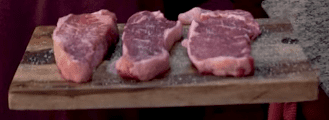
Let's take a look at the select steak. There is very little intramuscular fat which make it tough and chewy. Why is intramuscular fat important? Well simply put, that fat is where beef gets a lot of its flavor. The fat is where it's at .
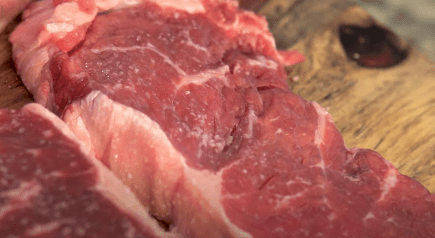
Next, take a look at the choice steak. You'll see relative to the select, there's much more of that flavor hiding right in between the meat.
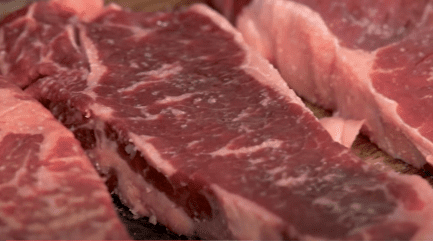
Last, we have the prime steak. The one thing I want you to notice is the difference in all the intramuscular fat versus the select. This is going to be a more expensive steak because you are paying for a higher quality, better tasting New York Strip. USDA Prime steaks are typically found at nice steak houses and restaurants. It represents only about 5% of the total beef available for purchase. So this is going to be a little harder to find, but it's out there.
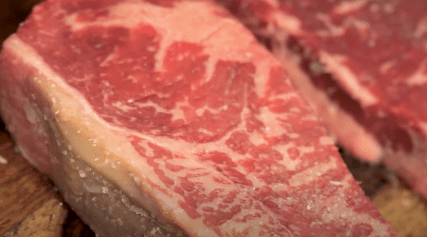
How to Cook Steak
You may notice that these steaks are already salted. Why did we do that? Well, we recently did a steak experiment, gauging the timing differences of salting the steak and its impact on flavor. So, these have been salted for an hour. Be sure to let your steak rest at room temperature before cooking to promote consistent cooking. If I'm not grilling my steak, I cook them in the cast-iron skillet. I also cut the steaks in half so they are all relatively the same size and only cooked with oil in order to isolate the flavor profile. For this experiment, we cooked these New York Strips to medium rare, so we pulled them off at about 130 degrees Fahrenheit. Once the steak reached your preferred temperature, let it rest for five minutes to let the internal juices redistribute.
Grades of Steak Taste Test RESULTS
Let's dig in to the select steak. It cuts very nicely. It's a good steak, but not a great steak. Even though it has a nice temperature, it still tastes a little bit dry to me. I was expecting a little bit more chew to the steak, so it is a bit better than I expected.
Let's move on over to the choice steak. The difference I see is a richer, "beefier" taste than the select steak. It is more tender than I expected, but still a little chewy. This is a good steak. You won't be disappointed with this steak.
Lastly, on to the prime steak. It is noticeably more tender than the other two steaks. Also, you get a lot more of that intramuscular fat. This is a phenomenal steak!
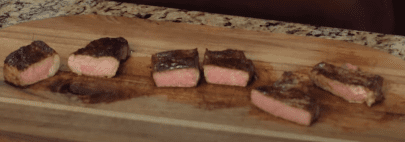
In closing, I have to say the USDA select steak performed better than I thought. However, if you are looking for a steak with great flavor and worth the money, I would recommend USDA choice or USDA prime steak. Our goal for this experiment was to educate you about the different USDA grades of steak so the next time you're in the store or restaurant you get the most bang for your buck!
If you found this experiment helpful, please drop a comment below. If you enjoy our videos, don' forget to to like, comment and subscribe to our Youtube channel, Red Meat Lover. As always, don't forget to turn up the tasty!
Print Recipe
A basic way to cook delicious steak!

Instructions
-
1. Even coat your steak with course ground salt and let steak rest at room temperature an hour before cooking. 2. Heat oil in pan on medium-high heat. 3. Cook steak 2-3 minutes on each side (depending on temperature preference). 4. Remove from heat and let steak rest for 5 minutes. 5. Enjoy!
Recipe Notes
This recipe is just a basic way to cook steak. You can turn up the tasty by adding fresh herbs and spices such as rosemary or garlic.
Source: https://redmeatlover.com/recipe/beef-grades-usda-steak-taste-test-select-vs-choice-vs-prime-steak/

0 Response to "Best Way to Cook Usda Select Beef"
Post a Comment